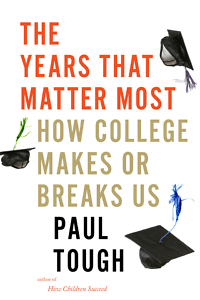Inside the Ivory Tower
Paul Tough reveals how American colleges try (and fail) to redress social inequality
The thesis of The Years That Matter Most, Paul Tough’s survey of American colleges, will not surprise anyone who has followed headlines regarding higher education over the last three decades. Americans want to idealize college as the great social leveler, the golden ticket that enables children of the working class to ascend to professional strata. In reality, the college system remains tilted in favor of the privileged. For low-income students, the ivory tower is no more accessible today than it was a generation ago.
 Tough, a contributing writer for The New York Times Magazine, makes a compelling case for his argument by combining personal stories of recent college students with data that connects their experiences with general trends. He spent six years researching colleges and interviewed dozens of students, professors, and administrators to gain a ground-level sense for how campuses operate.
Tough, a contributing writer for The New York Times Magazine, makes a compelling case for his argument by combining personal stories of recent college students with data that connects their experiences with general trends. He spent six years researching colleges and interviewed dozens of students, professors, and administrators to gain a ground-level sense for how campuses operate.
In the manner of Malcolm Gladwell, Tough also digests academic studies to illustrate aspects of academic reality. He employs the sociological term “cultural capital” to refer to “the knowledge and manners and taste that established families and institutions quietly pass on to their children.” As a scholarship student at the private Brentwood School in Los Angeles puts it, “There were these rules of being that everyone seemed to know. … Everyone except for me.”
Tough’s conclusions confirm the worst suspicions about colleges in the U.S. Far from the ideal of meritocracy, higher education is an interconnected network of institutions that perpetuate social inequities. The criteria colleges use for admissions (particularly their reliance on standardized tests) disproportionately favor students from high-income families, and elite colleges give advantage to children of alumni and wealthy donors. Students who can pay full tuition are admitted to selective colleges at much higher rates than ones seeking financial aid.
The news is not all bad. Tough reports on professors and administrators who have developed innovative programs to bring out the best in underprivileged students. He made several trips to the University of Texas at Austin, which in 2012 decided to launch an initiative to raise its four-year graduation rate from 51 percent to 70 percent. UT’s first “graduation-rate champion,” a chemistry professor named David Laude, noticed that the graduation rate for first-generation Longhorns lagged 20 points behind students whose parents were college graduates. Using a “kitchen-sink approach” — “small classes, peer mentoring, extra tutoring help, and engaged faculty advisers” — Laude saw graduation rates rise immediately: The four-year graduation rates for first-generation students increased from 41 percent in 2012 to 62 percent in 2018.
 Tough takes a more intimate look at a UT math professor, Uri Treisman, who won a MacArthur “genius” grant for his programs designed to assist students from under-represented groups to pursue careers in math and science. At UT, as elsewhere, the weed-out course is freshman calculus, which Treisman calls “a burial ground.” Treisman has learned that students like Ivonne Martinez, who graduated from a public high school in San Antonio and failed her first calculus exam, don’t need a watered-down curriculum; they simply need to know that they belong. Treisman encourages social study groups, student-led workshops, and frequent contact with instructors. His pedagogy has been so successful that it has been adopted by colleges all over the country. For Ivonne, Treisman’s personal attention made all the difference: She ultimately earned an A in calculus and is now on pace to graduate with a degree in higher mathematics.
Tough takes a more intimate look at a UT math professor, Uri Treisman, who won a MacArthur “genius” grant for his programs designed to assist students from under-represented groups to pursue careers in math and science. At UT, as elsewhere, the weed-out course is freshman calculus, which Treisman calls “a burial ground.” Treisman has learned that students like Ivonne Martinez, who graduated from a public high school in San Antonio and failed her first calculus exam, don’t need a watered-down curriculum; they simply need to know that they belong. Treisman encourages social study groups, student-led workshops, and frequent contact with instructors. His pedagogy has been so successful that it has been adopted by colleges all over the country. For Ivonne, Treisman’s personal attention made all the difference: She ultimately earned an A in calculus and is now on pace to graduate with a degree in higher mathematics.
Tough discusses the 2019 admissions scandal, a product of the same “ambitions and anxieties” that spur parents to spend $400 an hour on SAT tutors. The troubling truth is that such exorbitant costs may be worth it. According to a Stanford economist, attending a “highly selective college” (one where incoming freshmen have average SAT scores above 1400) means a student’s future lifetime earnings are likely to be $2 million more than if the same student attended a “nonselective college” open to most high school graduates. The gap grows larger with every step up the scale of selectivity.
For all its disparities, however, college remains the surest path for young people to climb the socio-economic ladder. Tough refutes the arguments that college isn’t worth the cost. In fact, as multiple studies have shown, earning a B.A. will substantially increase one’s lifetime earnings and long-term security. Tough acknowledges that, in a competitive world economy, a bachelor’s degree does not guarantee that one will “move up in the world,” but it is “an insurance policy against moving down.”

Sean Kinch grew up in Austin and attended Stanford. He earned a Ph.D. from the University of Texas. He now teaches English at Montgomery Bell Academy in Nashville.


